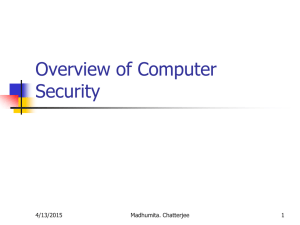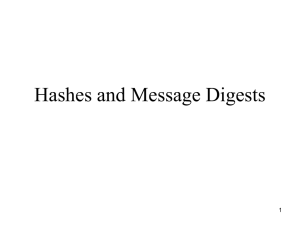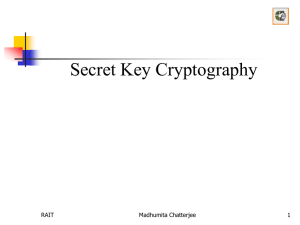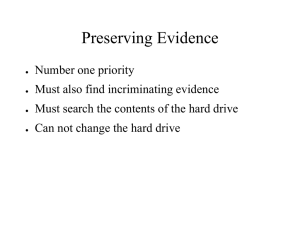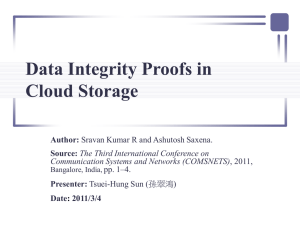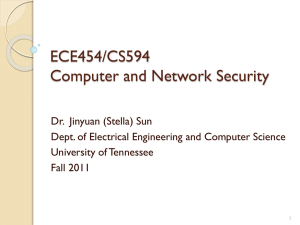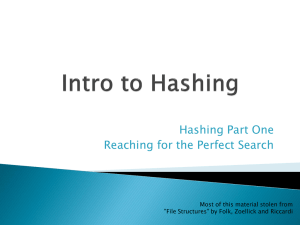Hashes and MDs
advertisement
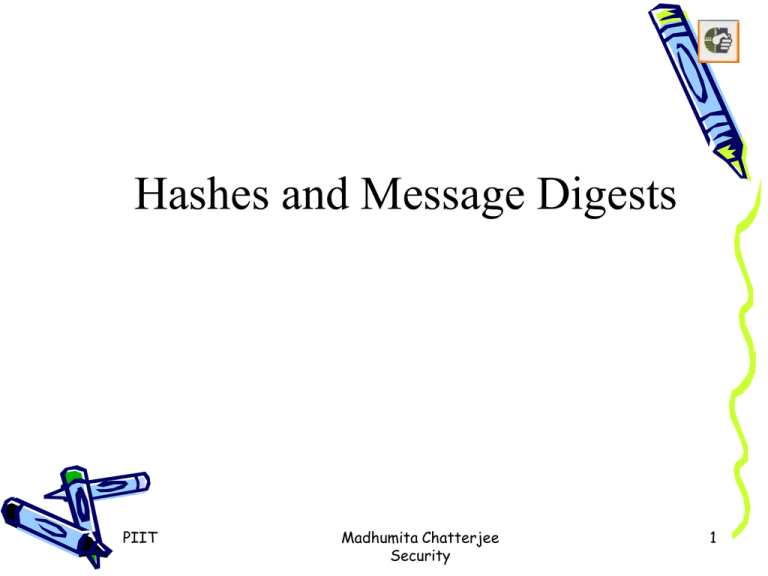
Hashes and Message Digests PIIT Madhumita Chatterjee Security 1 Hashes • Hash is also called message digest • One-way function: d=h(m) but no h’(d)=m – Cannot find the message given a digest • Cannot find m1, m2, where d1=d2 PIIT Madhumita Chatterjee Security 2 • A hash function condenses arbitrary message to fixed size h = H(M) • hash used to detect changes to message • can be used in various ways with message • most often to create a digital signature PIIT Madhumita Chatterjee Security 3 Cryptographic hash must provide the following • Compression – for any size of input x, y =h(x) must be small. Output must be fixed size • Efficiency- given x, it must be easy to compute h(x). • One-way: Given any valye y, it is computationally infeasible to find a valye x s.t h(x) = y PIIT Madhumita Chatterjee Security 4 Hash functions and Digital Signature PIIT Madhumita Chatterjee Security 5 Requirements for Hash Functions 1. can be applied to any size message M 2. produces a fixed-length output h 3. is easy to compute h=H(M) for any message M PIIT Madhumita Chatterjee Security 6 Properties of Hash functions 1. • given h is infeasible to find x s.t. H(x)=h one-way property 2. given x is infeasible to find y s.t. H(y)=H(x) • weak collision resistance • strong collision resistance 3. is infeasible to find any x,y s.t. H(y)=H(x) PIIT Madhumita Chatterjee Security 7 Hashes…… • Arbitrary-length message to fixedlength digest • Randomness – any bit in the outputs ‘1’ half the time – each output: 50% ‘1’ bits PIIT Madhumita Chatterjee Security 8 Simple Hash Functions • based on XOR of message blocks -divide the message into equal size blocks -perform XOR operation block by block -final output is the hash • not very secure • need a stronger cryptographic function PIIT Madhumita Chatterjee Security 9 Block Ciphers as Hash Functions • can use block ciphers as hash functions – – – – using H0=0 and zero-pad of final block compute: Hi = EMi [Hi-1] and use final block as the hash value similar to CBC but without a key • resulting hash is too small (64-bit) – Vulnerable to attacks PIIT Madhumita Chatterjee Security 10 Birthday Problem • Compute probability of different birthdays • Random sample of n people (birthdays) taken from k (365) days • kn samples with replacement • (k)n=k(k-1)…(k-n+1) sample without replacement • Probability of no repetition: – p = (k)n/kn 1 - n(n-1)/2k PIIT Madhumita Chatterjee Security 11 PIIT Madhumita Chatterjee Security 12 How Many Bits for Hash? • m bits, takes 2m/2 to find two with the same hash • 64 bits, takes 232 messages to search (doable) • Need at least 128 bits PIIT Madhumita Chatterjee Security 13 Using Hash for Authentication • • • • • Alice to Bob: challenge rA Bob to Alice: MD(KAB|rA) Bob to Alice: rB Alice to Bob: MD(KAB|rB) Only need to compare MD results PIIT Madhumita Chatterjee Security 14 Using Hash to Encrypt • One-time pad: – compute bit streams using MD, K, and IV • b1=MD(KAB|IV), bi=MD(KAB|bi-1), … – with message blocks • Or mixing in the plaintext – similar to cipher feedback mode (CFB) • b1=MD(KAB|IV), c1= p1 b1 • b2=MD(KAB| c1), c2= p2 b2 PIIT Madhumita Chatterjee Security 15 Using Secret Key for a Hash • Unix password algorithm: – Compute hash of user password, store the hash (not the password), and compare the hash of user-input password. • First 8 bytes of password used to form a secret key. • Encrypt 0 with a DES-like algorithm (why not use a “system” key to encrypt the password?). PIIT Madhumita Chatterjee Security 16 – Salt: • 12-bit random number formed from time and process ID. • Determine bits to duplicate in the mangler when expanding from 32 to 48 bits. • Salt stored with hashed result. PIIT Madhumita Chatterjee Security 17 MD2 • 128-bit message digest: – Arbitrary number of bytes of message – First pad to multiple of 16 bytes – Append MD2 checksum (16 bytes) to the end • The checksum is almost a MD, but not cryptographically secure by itself. – Process whole message PIIT Madhumita Chatterjee Security 18 MD2 Checksum • • • • One byte at a time, k 16 steps mnk: byte nk of message cn=(mnk cn-1) cn : 0 41, 1 46, … – Substitution on 0-255 (value of the byte) PIIT Madhumita Chatterjee Security 19 MD2 Final Pass • Operate on 16-byte chunks • 48-byte quantity q: – (current digest|chunk|digestchunk) • 18 passes of massaging over q, and one byte at a time: – cn=(cn-1) cn for n = 0, … 47; c-1 = 0 for pass 0; c-1 = (c47 + pass #) mod 256 • After pass 17, use first 16 bytes as new digest – 16 8 = 128 PIIT Madhumita Chatterjee Security 20 MD5: Message Digest Version 5 input Message Output 128 bits Digest PIIT Madhumita Chatterjee Security 21 MD5 Box 512-bit message chunks (16 words) F: (xy)(~x z) G:(x z) (y ~ z) H:xy z I: y(x ~z) +: binary sum xy: x left rotate y bits Initial 128-bit vector 128-bit result PIIT Madhumita Chatterjee Security 22 MD5: Padding 1 2 3 4 input Message 512 bit block Initial Value Padding MD5 Transformation block by block Output 128 bits Digest PIIT Madhumita Chatterjee Security Final Output 23 Padding Twist • Given original message M, add padding bits “10*” such that resulting length is 64 bits less than a multiple of 512 bits. • Append (original length in bits mod 264), represented in 64 bits to the padded message • Final message is chopped 512 bits a block PIIT Madhumita Chatterjee Security 24 MD5 Process • As many stages as the number of 512-bit blocks in the final padded message • Digest: 4 32-bit words: MD=A|B|C|D • Every message block contains 16 32-bit words: m0|m1|m2…|m15 – Digest MD0 initialized to: A=01234567,B=89abcdef,C=fedcba98, D=76543210 – Every stage consists of 4 passes over the message block, each modifying MD PIIT Madhumita Chatterjee Security 25 MD5 Blocks 512: B1 MD5 512: B2 MD5 512: B3 MD5 512: B4 MD5 Result PIIT Madhumita Chatterjee Security 26 Processing of Block mi - 4 Passes mi MDi ABCD=fF(ABCD,mi,T[1..16]) A C D B ABCD=fG(ABCD,mi,T[17..32]) ABCD=fH(ABCD,mi,T[33..48]) ABCD=fI(ABCD,mi,T[49..64]) + PIIT MD i+1 + + Madhumita Chatterjee Security + 27 Different Passes... • Different functions and constants are used • Different set of mi is used • Different set of shift amount is used PIIT Madhumita Chatterjee Security 28 Functions and Random Numbers • F(x,y,z) == (xy)(~x z) – selection function • • • • G(x,y,z) == (x z) (y ~ z) H(x,y,z) == xy z I(x,y,z) == y(x ~z) Ti = int(232 * abs(sin(i))), 0<i<65 PIIT Madhumita Chatterjee Security 29 Secure Hash Algorithm • Developed by NIST, specified in the Secure Hash Standard (SHS, FIPS Pub 180), 1993 • SHA is specified as the hash algorithm in the Digital Signature Standard (DSS), NIST PIIT Madhumita Chatterjee Security 30 General Logic • Input message must be < 264 bits – not really a problem • Message is processed in 512-bit blocks sequentially • Message digest is 160 bits • SHA design is similar to MD5, but a lot stronger PIIT Madhumita Chatterjee Security 31 Basic Steps Step1: Padding Step2: Appending length as 64 bit unsigned Step3: Initialize MD buffer 5 32-bit words A|B|C|D|E A = 67452301 B = efcdab89 C = 98badcfe PIIT Madhumita Chatterjee Security D = 10325476 32 Basic Steps... Step 4: the 80-step processing of 512-bit blocks – 4 rounds, 20 steps each. Each step t (0 <= t <= 79): – Input: • Wt – a 32-bit word from the message • Kt – a constant. • ABCDE: current MD. – Output: • ABCDE: new MD. PIIT Madhumita Chatterjee Security 33 Basic Steps... • Only 4 per-round distinctive additive constants 0 <=t<= 19 Kt = 5A827999 20<=t<=39 Kt = 6ED9EBA1 40<=t<=59 Kt = 8F1BBCDC 60<=t<=79 Kt = CA62C1D6 PIIT Madhumita Chatterjee Security 34 Basic Steps - The Heart Of The Matter A B C D E + ft + CLS5 + CLS30 PIIT A B + C Madhumita Chatterjee Security D E Wt Kt 35 Basic Logic Functions • Only 3 different functions Round 0 <=t<= 19 20<=t<=39 40<=t<=59 60<=t<=79 PIIT Function ft(B,C,D) (BC)(~B D) BCD (BC)(BD)(CD) BCD Madhumita Chatterjee Security 36 Twist With Wt’s • Additional mixing used with input message 512-bit block W0|W1|…|W15 = m0|m1|m2…|m15 For 15 < t <80: Wt = Wt-16 Wt-14 Wt-8 Wt-3 • XOR is a very efficient operation, but with multilevel shifting, it should produce very extensive and random mixing! PIIT Madhumita Chatterjee Security 37 SHA Versus MD5 • SHA is a stronger algorithm: – Brute-force birthday attacks requires on the order of 280 operations vs. 264 for MD5 • SHA’s 80 steps and 160 bits hash (vs. 128) requires a little more computation PIIT Madhumita Chatterjee Security 38
